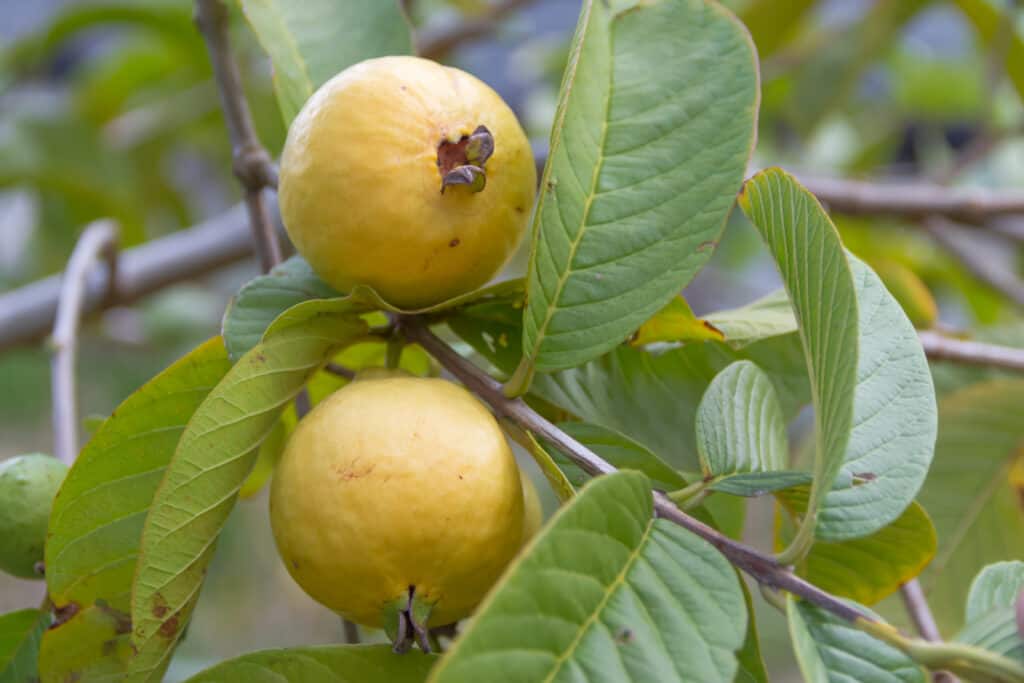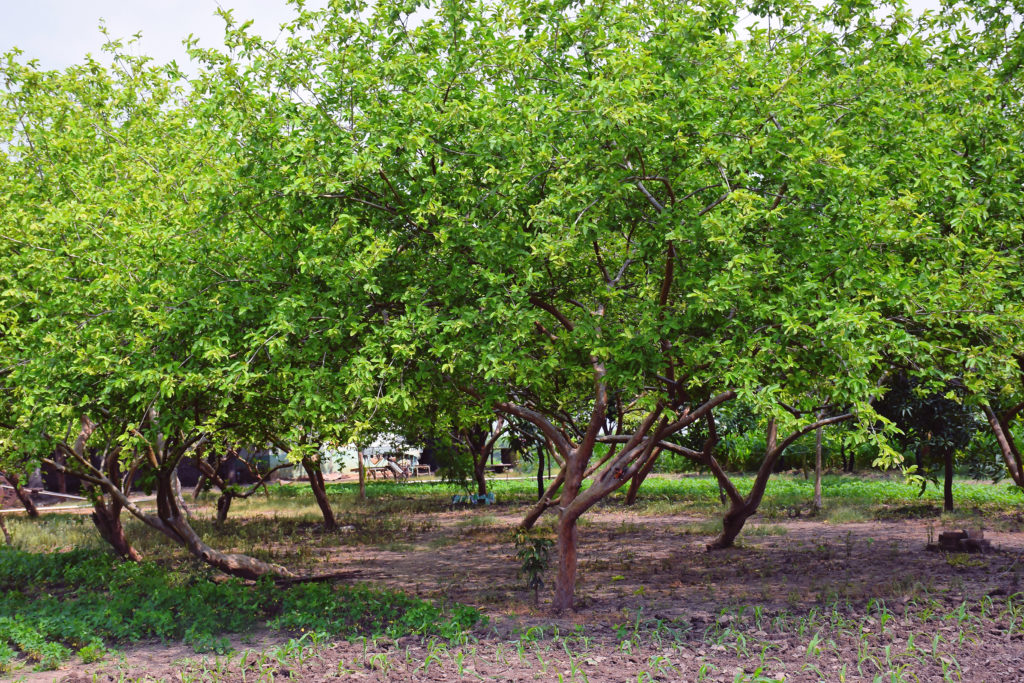Grow guava in your garden. Guava is a tropical and subtropical plant.
Guava is native to Southern Mexico. In the United States, it is grown mostly in Florida, Hawaii, Southern California, and parts of Texas. With protection, it can be grown in USDA Zones 8b and 9.
Guava is round to pear-shaped fruit commonly 2 to 3 inches long. Guava can be green, yellow, red, purple, or black-skinned. The flesh can be white, yellow, coral, or red. Ripe guava has sweet, moist flesh that is highly scented. Each fruit has several small, hard, but edible seeds.
Related article:

Ripe guava can be halved and eaten from the shell or sliced and combined with other fruit. Guava can be pureed and made into sauces, sorbets, and mousses, or cooked down into a firm paste and sliced. It can be made into jellies, jams, and preserves. Guava can also be juiced.
In tropical regions, some guavas can grow to 30 feet tall, but in subtropical regions such as Southern California guava will grow to not more than 10 or 12 feet tall. There are dwarf guava cultivars.
The botanical name for guava is Psidium guajava.
Best climate and site for growing guava
- Guava can be grown in both humid and dry climates; the optimal temperature for growing guava is 68°to 82°
- Guava can be grown in USDA zones 9 to 12. In zones 9a and 8b, guava should be protected from frost or chilly weather. Guava will be damaged by frost; it may recover from exposure to temperatures as low as 29°F but will likely lose all of its leaves.
- Plant guava in full sun; in dessert regions plant guava in partial shade or protect plants from the midday sun.
- Plant guavas in compost-rich, well-drained soil.
- Guavas will grow where the soil pH ranges from 4.5 to 9.4; a neutral pH is of 6.0 to 7.0 is optimal.
- Avoid planting guava in low spots where cold air and cross can settle.
Choosing the right guava plant
- Choose a guava variety that will fit your garden; dwarf guavas grow to 3 feet tall; standard cultivars grow to 12 feet tall or taller. Some varieties can grow to nearly 30 feet tall in tropical climates.
Guava pollination
- Guavas are mostly self-fruitful. Some cultivars may produce more fruit when cross-pollinated with another variety.
- Guavas bloom throughout the year, but the time of the heaviest bloom is with the onset of warm weather in spring.
- Honeybees are the chief guava pollinator.
Guava yield
- Mature guava can produce 50 to 80 pounds of fruit each year.
Spacing guava
- Consider the size of the tree at maturity when spacing guava in the garden. Most cultivars for home gardens can be planted 10 to 15 feet apart or less.

Planting guava
- Prepare a planting site in full sun that is sheltered from a prevailing breeze or wind. A south-facing wall that can collect and radiate solar heat is a good spot in cooler locations.
- Work well-rotted compost or manure into the soil.
- Dig a hole half again as deep and twice as wide as the tree’s roots. Add a cupful of all-purpose fertilizer to the bottom of the hole.
- Put a tree stake in place before planting. Drive the stake into the ground to the side of the hole to be at least 2 feet deep.
- Set the plant in the hole so that the soil mark from the nursery pot on the stem is at the surface level of the surrounding soil. Spread the roots out in all directions.
- Re-fill the hole with half native soil and half aged compost or commercial organic planting mix; firm in the soil so that there are no air pockets among the roots. Water in the soil and create a modest soil basin around the trunk to hold water at watering time.
- Secure the tree to the stake with tree ties.
- After planting, water each tree thoroughly and fertilize it with a high-phosphorus liquid starter fertilizer.
Container growing guava
- Small and dwarf guava cultivars can be grown in containers.
- Guavas can be grown in a sunroom or greenhouse where there is ample light.
- Choose a container 24 inches wide and deep; use potting soil formulated for citrus or palm trees.
Guava care, feeding, and watering
- Keep the soil evenly moist for best fruit production; allow the top 2 or 3 inches of soil to dry before watering again. If the soil goes completely dry, flowering may be delayed or fruit may drop. Reduce water in winter.
- Guavas are heavy feeders; make monthly applications of an organic balanced fertilizer such as 5-5-5.
- Protect guavas from cold weather and frost; cover plants with a plant blanket if frost threatens or place a frame around the plant and cover the frame with clear plastic sheeting. A string of electric lights can be placed inside the frame for added warmth. Move guavas in containers to a protected and warm spot.
Pruning guava
- Most guavas can be maintained at 6 to 10 feet tall with annual pruning. Pinch out growing tips to keep guava small.
- Remove water sprouts and suckers regularly.
- Prune out broken, dead, and diseased wood.
- The fruit is borne on new growth, so pruning will not interfere with next year’s crop.
- Trees will blossom 10 to 12 weeks after pruning; if not pruned guava will blossom in autumn.
Thinning guava
- Thin fruit so that no more than 4 fruits mature on each branch.

Harvesting and storing guava
- Guava grown from seed will bear fruit in about 8 years; from seedling, guava will produce fruit in 3 to 5 years.
- Guava fruit will be ripe and ready for harvest about 20 to 28 weeks after flowering and pollination.
- In warm year-round locations, guava can produce two crops each year, a large crop in summer followed by a smaller crop in winter or spring.
- Ripe guavas will develop mature colors as they ripen; ripe guava will be fully colored and have a sweet aroma. Ripe guava will give slightly to gentle pressure.
- For the best flavor, let guava ripen on the tree.
- Ripe fruit will keep in the refrigerator for up to two weeks
- Green-mature fruits can be ripened at room temperature; place guava in a brown paper bag with a banana to hasten ripening.
- Mature green fruit can be stored for 2 to 5 weeks at 46° to 50°F and 85 to 95 percent humidity
Propagating guava
- Guava can be grown from seed; seeds take 2 to 8 weeks to germinate. Seeds do not always grow true.
- Guavas can be grafted by patch budding, side-veneer grafting, and marcotting.
- Guavas can be grown from root cuttings; place 5 to 10-inch root cuttings in potting mix and cover with 2 to 4 inches of soil.
- Softwood cuttings can be rooted; treat cuttings with a rooting hormone and provide bottom heat.
Guava problems and controls
- Anthracnose fungal disease can attack foliage in humid climates; apply fungicides
- Root-rot nematodes can reduce plant vigor; there is no control apart from solarizing the soil.
- Guava whitefly, guava moth, and Caribbean fruit fly can attack guava in southern Florida. Use yellow sticky traps and pheromone traps to control these pests.
Guava varieties to grow
The guava varieties listed here will grow in most home gardens; most of these cultivars will not grow taller than 10 to 15 feet depending on the climate and location.
- ‘Beaumont’: mildly acid taste; pink flesh; seedy; medium to large, roundish fruits weighing up to 8 ounces; excellent for processing; wide-spreading, very productive tree.
- ‘Detwiler’: relatively sweet, of pleasant flavor; yellowish to salmon flesh; medium to large, roundish fruit, about 3 inches in diameter; greenish-yellow skin, moderately thick; the tree is a very heavy bearer.
- ‘Hong Kong Pink’: subacid to sweet flavor; few seeds; pinkish-red flesh; medium to large, roundish fruit weighing 6 – 8 ounces; spreading tree, high yielding.
- ‘Indonesian Seedless’: good flavor and aroma; seedless; white flesh; small fruit with yellow skin; dwarf cultivar available.
- ‘Lucknow 49’: sweet flavor; few seeds, seeds are soft; milky white flesh; greenish-yellow thick skin; prolific bearer.
- ‘Mexican Cream’: very sweet, fine-textured, excellent for dessert; creamy white flesh; small to medium-small, roundish fruits; light yellow skin, slightly blushed with red; upright tree.
- ‘Patricia’: strawberry flavor; salmon-colored flesh; prolific bearer.
- ‘Psidium Guajava Nana’: dwarf tree, less than 3 feet; sweet flavor; pink flesh; fruit to 2 inches long; requires little pruning.
- ‘Red Indian’: sweet flavor; medium thick red flesh; numerous seeds; medium-large, roundish fruit with a strong odor; yellow skin yellow, often with a pink blush.
- ‘Ruby X’: delicious, sweet flavor; dark pinkish-orange flesh; small, roundish fruit; greenish-yellow skin; a bushy low growing tree with drooping branches.
- ‘Sweet White Indonesian’: sweet, delicious flavor; thick white, melting flesh; large, round fruit, 4 inches or more in diameter; thin, pale yellow skin; edible seeds surrounded by juicy pulp; fast-growing tree, bears several times a year.
- ‘Tikal’: sweet flavor; aromatic; pinkish flesh; juicy; large, baseball-size fruit; yellowish-green skin.
- ‘White Indian’: excellent, sprightly flavor; small to medium-sized fruit; moderately seedy.
- ‘White Seedless’: white flesh of good quality; improved selection from Florida with seedless.
Also of interest:
How to Grow Feijoa Strawberry Guava
Related articles:
Planning the Home Fruit Garden
Garden Planning Books at Amazon:
- Vegetable Garden Almanac & Planner
- Kitchen Garden Grower’s Guide Vegetable Encyclopedia
- Vegetable Garden Grower’s Guide
- Tomato Grower’s Answer Book
More fruit-growing article:
Learn how to plant, grow, prune, and harvest your favorite fruits. Click below for all you need to know.
- Apple
- Apricot
- Avocado
- Banana
- Blackberry
- Blueberry
- Cantaloupe
- Chayote
- Cherimoya
- Cherry
- Citrus
- Clementine
- Cranberry
- Currants
- Elderberry
- Feijoa
- Fig
- Gooseberry
- Grape
- Grapefruit
- Guava
- Kiwifruit
- Kumquat
- Lemon
- Lime
- Loquat
- Mandarin
- Mango
- Melon
- Mulberry
- Muskmelon
- Nectarine
- Olive
- Orange
- Papaya
- Passion Fruit
- Peach
- Pear
- Persimmon
- Pineapple
- Pineapple Guava
- Plantain
- Plum
- Pomegranate
- Pumpkin
- Quince
- Raspberry
- Strawberry
- Tangelo
- Tangerine
- Tangor
- Watermelon



